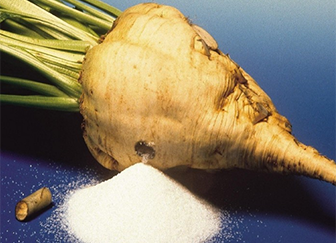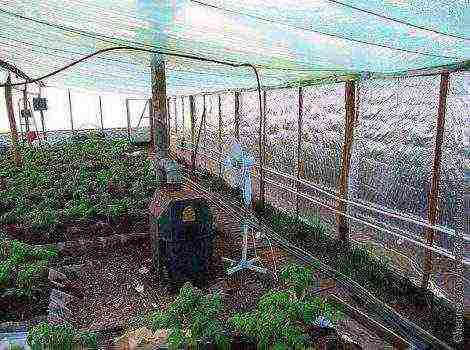Content [show]
As you know, self-grown food products are much healthier than their store counterparts. Fortunately, you don't need to be a farmer or even live near a village to enjoy these benefits. If your home has a sunny window and you have a little free time, then you can grow many food items with your own hands. Read our roundup for 16 healthy plants to grow at home.
General Tips
Before you get started, check out a few tips that are relevant no matter which plant you choose from the list.
- All of these plants require well-drained soil, which means you will need to use a pot with holes in the bottom or place a few rocks on the bottom before adding soil. This will allow water to drain through the stones. If you decide to use a pot with holes, be sure to place the drainage container so that no water can spill onto the windowsill or floor.
- For each of these plants, you can buy special fertilizers at the garden center or make your own.
- Many of these plants grow best in areas that receive ample sunlight and remain fairly warm throughout the day.
Avocado

An avocado tree can be grown from seed, but it will not produce edible fruit. If you want to eat what you grow, it is best to purchase a dwarf avocado plant. It can produce green or black fruits. To plant an avocado, add some sand to the bottom of a large, well-drained pot. Then you should fill it with soil and plant a tree. The avocado should be watered regularly, but the soil should not be too wet. Place the seedling in a room with high ceilings, as even bonsai can grow taller than three meters.
Carrot

Buy carrot seeds and a box or pot that is at least half a meter high with drainage holes in the bottom. Fill the container with humus-rich soil. Before planting seeds, the soil must be watered. They must be covered with a thin layer of soil after planting. The container should be placed in an area that is well lit throughout the day. The soil should be moist, but not too moist. Seedlings will appear in about two weeks.
Green garlic
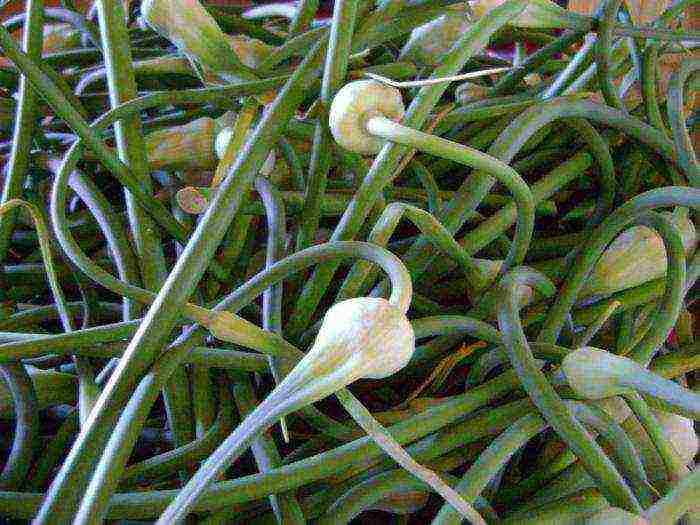
Growing heads of garlic indoors is much more difficult, but you can easily grow herbs that are used in the same way as chives. Buy a few small cloves of garlic. Also choose a pot with drainage holes in the bottom, and a small bag of fertilizer. Divide the head of garlic into cloves and plant them in the soil, pointed end up. Water the soil and place the container in a sunny location. Water the seedlings regularly and make sure the soil remains moist, but not soggy. Green shoots should appear in about a month.
Lemon
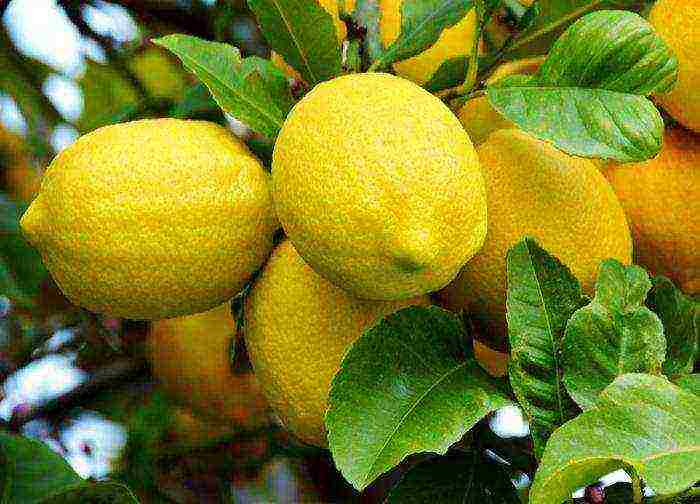
If you want to be able to harvest immediately, you can buy a one- or two-year-old tree. The pot for it should be made of ceramic, clay or plastic. The size of the pot should only slightly exceed the volume of the roots of the tree. Make sure the pot has multiple holes at the bottom. It is advisable to fill the drainage container with stones, this will allow the air to circulate. You can choose the soil that has been specially formulated for citrus trees. Lemon needs moist air, so spraying the leaves regularly will help keep them fresh.
Mandarin
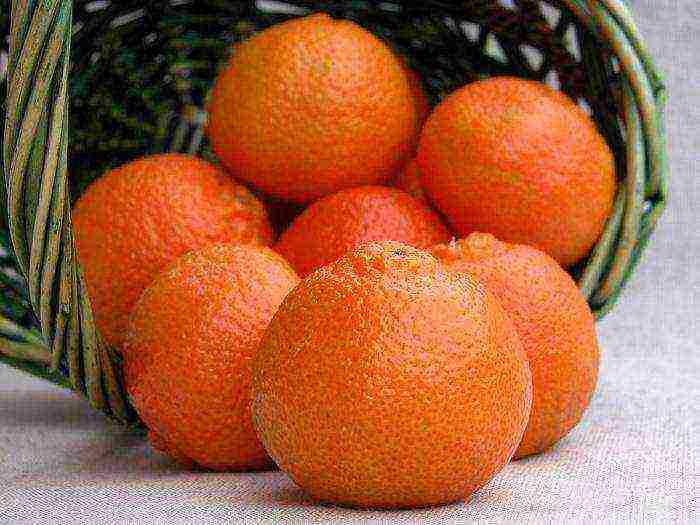
As with lemon, it is best to buy a dwarf tangerine tree. It will grow best in a spacious pot with drainage at the bottom and in rich soil. Also mandarin requires sunlight. It must be rotated regularly so that the light falls evenly from all directions. Water the plant regularly, although you can allow it to dry out a little between waterings. The tree can grow up to one and a half meters, and the root system along with it. When roots begin to show through the drainage holes, it's time to transplant the tangerine into a larger pot.
Microgreen

Purchase seeds from a variety of plants, such as radishes, cabbage, beets, basil, and dill. Microgreening requires a shallow tray with drainage holes. The soil should be moistened with water, but it should not be too wet. Sow the seeds evenly into the soil, they should be close to each other, but not touching. To close them, you need to sift through a thin layer of soil. Then use a spray bottle to create a light mist. Place the tray in a sunny location. The greens can be consumed three weeks after sowing.
Mushrooms
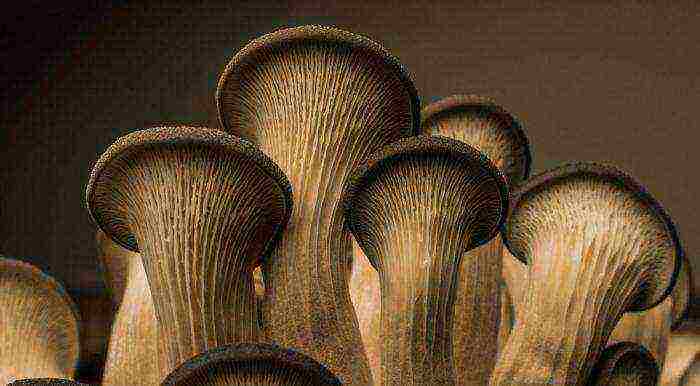
The easiest way to grow mushrooms indoors is to use a laundry basket. You can also purchase a special kit for growing them.
Salad

Purchase seeds or seedlings. It must be planted in a box that has drainage holes. The seeds must be pushed into the soil and watered.
Green onions

No seeds are required to grow it. To grow your own crop, just buy a bunch of green onions, fasten the bulbs together with an elastic band and place them in a glass of water. When new green shoots appear and roots begin to grow in the water, the onions can be transplanted into a shallow container. Plants need to be watered regularly and kept in the sun.
Tomatoes

To grow tomatoes, you need a large pot with drainage holes. To harvest regularly, you need to plant new plants every few weeks. The seeds are immersed in the soil and watered. The soil should be moist, but not soggy. Seeds germinate in 5-10 days. After the new plants have risen a few centimeters, they must be transplanted into fresh soil. About two weeks after planting the seedlings, organic fertilizers and mixtures can be added.
Basil
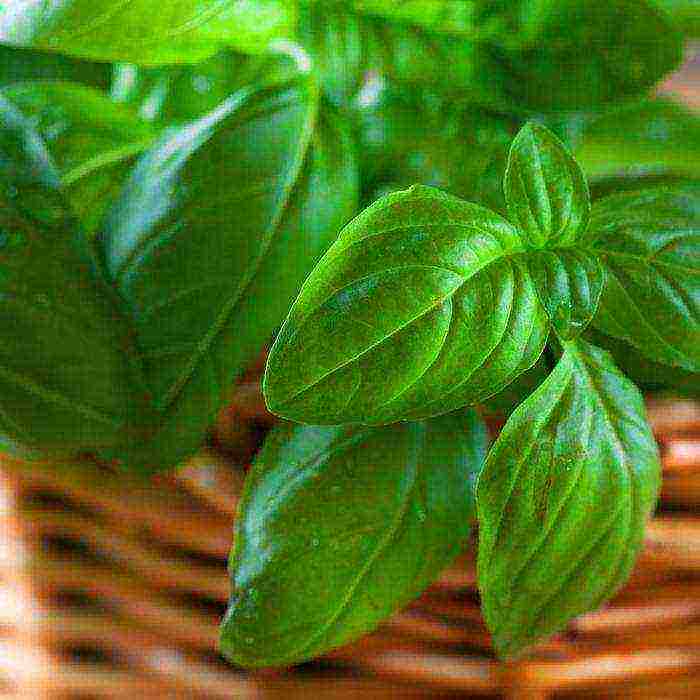
For a bountiful harvest of basil, it is very important to choose a container with good drainage holes. Basil loves warm temperatures and lots of sunshine for at least six hours every day. You can fertilize the soil once a month. If the room temperature is very high, water the basil every day. If the temperature is acceptable, then every other day.Pruning can also help you maximize your basil yield. In addition, you need to remove the flowers when they start to appear.
Chivis
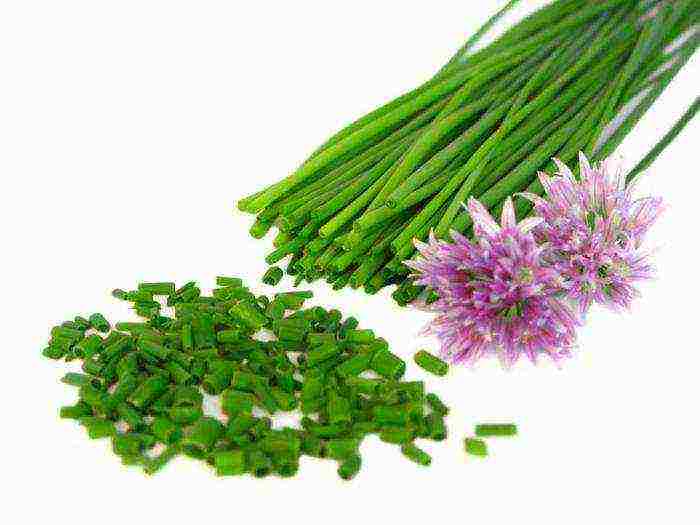
The pot for this type of onion must be filled almost to the top with soil. After sowing, the seeds should be covered with a thin layer of soil. The container should be in a partially shaded area. Water regularly, the soil should not dry out.
Coriander
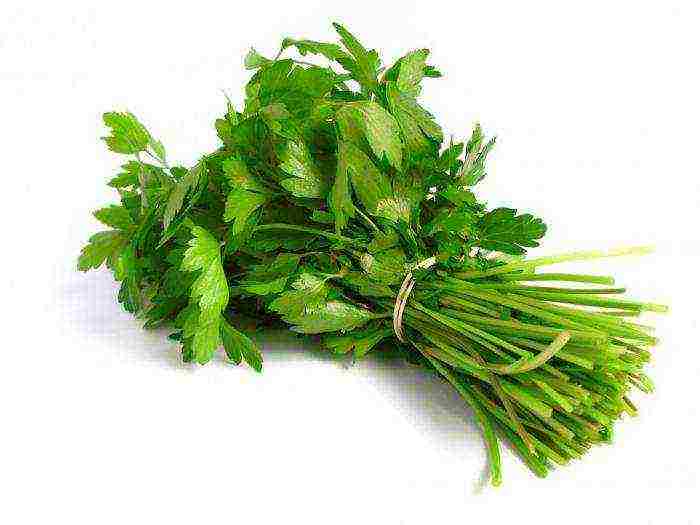
The seeds of this plant must be sown into the soil, covered with a thin layer, and then watered. Cover the container immediately with plastic wrap, securing it with rubber bands. You need to remove it when the seedlings have already appeared and have reached the level of the film. This may take several days. Water your seedlings every day and keep them in a place that gets enough sunlight.
Ginger

It is easy to grow it. Just buy ginger root from the grocery store and cover it with soil in a container. In this case, the prospective buds should be directed face up. The container must be placed in a place that receives scattered sunlight, and you can wait for seedlings. The soil should be watered regularly and should not be dry.
Mint
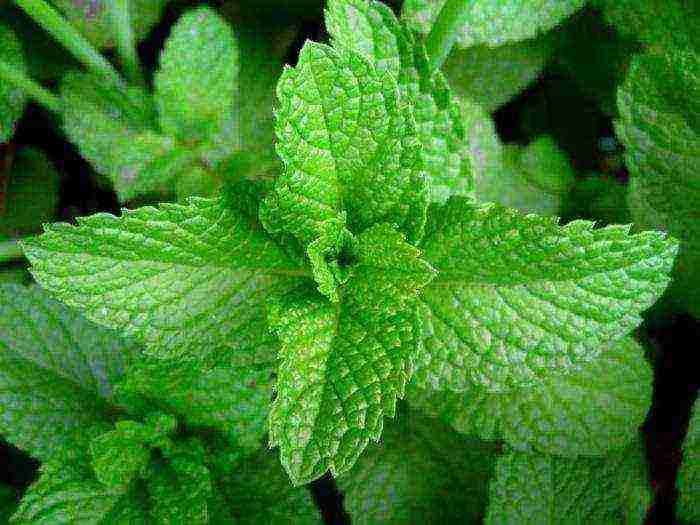
Plant the seeds of the plant in a large, deep pot as mint tends to thrive. The pot should be left in a place that receives sufficient heat and sunlight. Water the mint regularly to keep the soil from drying out.
Rosemary

Start by planting the seeds in a container with holes in the bottom for drainage. It is best to use soil mixed with coarse sand. You can also add a teaspoon of lime to make the soil alkaline. The container should be placed on the sunny side. Rosemary will grow best if it is exposed to sunlight for at least six hours a day. Watering is necessary if the topsoil is dry to the touch.
Indoor flowers add colors to our life, create mood and home comfort. They can be of immense benefit to their owners. Therefore, you need to choose them correctly, since certain types not only enliven the room, but also improve well-being, warm in the cold and simply delight the eye.
Useful properties of home plants
Here are the main ones:
- In poorly ventilated rooms, carbon dioxide builds up. Flowers absorb it and oxygenate the air.
- Medicinal plant species treat cuts, burns, colds and other ailments.
- In winter, the air in the room becomes dry due to the operation of the heating system, which affects the condition of the skin and well-being. Flowers help humidify the air.
- Plants absorb electromagnetic radiation from household appliances and home appliances. It can affect a person's well-being, causing insomnia and headaches.
- We are surrounded by objects that can emit toxic substances. The city air contains a lot of dust, exhaust gases, heavy metals from the emissions of factories and enterprises. Plants purify the air, kill microbes with their phytoncides and absorb harmful impurities.
- Folk beliefs endow indoor flowers with the properties of bringing happiness, harmony, tranquility, etc. We have included in our review some plants that, according to signs, are useful for their owners.
Indoor plants: we choose for ourselves and loved ones
Aloe
This is a well-known home doctor. It will help with colds, inflammations, can stop bleeding and heal wounds. Its juice is used to treat throat, heartburn, gastritis, gum disease and other diseases. It is often used for cosmetic purposes.
Chlorophytum
It is also very useful to keep it in the house. It is a bushy plant with thin and bending leaves that have light stripes. It will help get rid of moldy fungi and pathogenic bacteria, cleanse the air of harmful substances present in it. Chlorophytum will bring peace and comfort to your home.
Peppermint
Great for growing in a pot on a windowsill. It improves appetite and stimulates the digestive process. Its leaves are good to use as a seasoning for various dishes and to brew tea with them.
Violet
Many favorite plant will perfectly fit into the interior of the kitchen and will not take up much space. Violet will cleanse and humidify the air from carbon monoxide gases. This flower is a symbol of peace and tranquility in family relationships. White flowers are believed to help relieve sadness, fatigue, and depression. Blue violets are suitable for creative people. They provide peace of mind, stimulate spiritual growth, and build character. Flowers of red and pink color cheer up and are able to protect their owner from diseases.
Ficus
It copes well with the task of collecting dust that settles on its leathery leaves. They are very easy to wash or wipe with a damp cloth. Ficus will saturate the room with oxygen, purify the air from unpleasant odors. It improves family relationships, soothes and relieves anxious thoughts.
Vines
A beautiful vine, for example, scindapsus, looks good in a hanging planter. It has green, heart-shaped leaves with yellowish specks. It is unpretentious and perfectly cleans the air. Scindapsus converts lazy energy into activity. It can be placed in the kitchen.
Wax ivy
It is a curly flower with hard oval leaves. Has white, pink or red umbrella inflorescences. The plant neutralizes negative energy in the house, protects the owner from troubles and cleans the air from microbes.
Geranium
Lush curly geranium has many medicinal properties. It scares away moths and evil spirits, relieves irritability, normalizes sleep and fights disease-causing bacteria. Her mere presence in the house attracts good luck and the fulfillment of desires. The scent of these flowers relaxes and relieves headaches. If the plant withers, then it is believed that one of the household members may get sick.
Fat woman
This plant can be squat or tall, with a thick trunk. It is often called the money tree. The fat woman has small dark green leaves that are located on the branches in a symmetrical manner. They look like small coins. Therefore, it is believed that the fat woman is able to attract material goods into the house.
Sansevieria (mother-in-law's language)
Quite tall plant with massive, elongated leaves. They are solid and dark green in color. They also have light stripes in the middle or white spots. The flower improves family relationships and brings harmony. Its leaves are antiseptic, which is why they are widely used in folk medicine. Sansevieria juice is used to heal wounds, and the plant is also capable of stopping blood.
Oxalis
This bushy plant is purple in color. Its leaves resemble a flock of butterflies. During flowering, small white umbrella flowers appear on it. The branches of the flower can intertwine with each other. Oxalis leaves can be used in cooking, for example, added to salads. They taste like sorrel. The plant improves intuition, sharpens the senses. It can be held by those who wish to meet a soul mate and attract attention to themselves.
Cactus (echinopsis)
Has a slightly elongated spherical shape. Its ribbed body is covered with small needles. If you take good care of the cactus, it will bloom towards the end of spring. And every year a shaggy soft arrow will appear on it, from which a bud with a wonderful aroma will then open. It will bloom for up to 3 days. The cactus is placed near a TV or computer and in other places with hazardous radiation.
Citrus
All citrus fruits calm the nervous system and relieve stress. The tree can be grown from lemon or tangerine seeds. The leaves, just like the fruits, are capable of having a beneficial effect.Plants secrete essential oils that help calm, relieve stress and fatigue, and promote healthy and sound sleep.
Myrtle or eucalyptus
These plants are perfect for a bedroom. Their leaves secrete substances that make breathing easier and relieve bronchial spasms. It is very beneficial for people with asthma and respiratory diseases.
It is customary to give myrtle to newlyweds, as it is a symbol of long and happy family relationships. It must be carefully looked after so that the plant does not die and does not take its well-being with it.
Araucaria
Thanks to her, the room will be filled with the freshness of the coniferous forest. It is a miniature pyramidal tree with soft needles. The plant cleans the air perfectly.
Spathiphyllum
Many flowers, according to signs, bring harmony and love to the house. For example, spathiphyllum is a symbol of female happiness. He helps the girl in search of her soul mate and keeps the relationship of a married woman.
Aichrizon
This is a small 30-centimeter plant with heart-shaped leaves that will make its owner happy and bring her good luck in love.
Dwarf pomegranate
It is believed that its fruits can strengthen the marital relationship if the husband and wife try them together.
Anthurium
It is recommended to put red flowers in the bedroom. They bring harmony and mutual feelings into the life of a married couple. Anthurium has glossy dark green heart-shaped leaves. This flower is believed to bring good luck to its male owner. Anthurium is a symbol of courage, masculine strength, passion, striving for freedom and love.
Calla
It has long leaves and single folded flowers. She protects the house and generates joy and goodness, and also transforms negative energy into positive.
Camellia
Red camellia can help freshen up relationships. Its inflorescences are similar to peonies. The plant brings success in creativity and career.
Kalanchoe
It has small inflorescences of different colors. This is a real home doctor. The flower heals cuts, heals colds, regenerates the skin, relieves stomach ulcers and even varicose veins.
Cyclamen
Indoor plant with dark, matte leaves, which contain white blotches. Cyclamen inflorescences resemble butterflies, their shade can be different. Most often, one shade fades into another. Flowers have a strong energy. They help get rid of fears, depression, bad dreams.
Calathea
This is a flower with large oval leaves, on which a grooved pattern is applied. During flowering, small white or yellow flowers appear. The flower cleans the air well and absorbs negative energy. Signs suggest that calathea creates a peaceful atmosphere in the family.
Plant and grow plants and flowers at home, and the atmosphere around you will be filled with positive energy and pleasant aromas!
Similar articles:
Unpretentious indoor plants, or landscaping a house for the lazy
Houseplants that purify the air
Unpretentious indoor plants blooming all year round
Houseplants decorate the house and make the life of the modern city dweller more joyful. And even if the city apartment is not always sunny and spacious. There are many - large and compact, bright and modest shade-loving, decorative deciduous and flowering - that can decorate any home, even a dark hallway. For example, those that do not need bright lighting.
Shade-loving indoor plants
In urban dwellings, there is often a shortage of well-lit, sunny places. Therefore, those who love shade are especially appreciated. Sciophytes - "plants of the shade" - this is how the representatives of the flora, who prefer shaded places, are called. They are also known as heliophobes - those who are afraid of the sun.
These amazing plants feel comfortable in partial shade, out of direct sunlight.Only here their beauty is fully revealed, the leaves become fabulously decorative, and the flowering becomes the most effective and abundant.
Bright light if not destructive, then definitely - not useful... The ancestral home is the gloomy deciduous forests of various parts of the world. Under their canopy, the leaves acquire an exotic color, only here flowering is possible.
Many shade-tolerant inhabitants of the lower tiers of tropical and subtropical forests settled in city apartments. And now the best places for them are the northern and western home windowsills, the shaded corners of the rooms, where only diffused light falls.
Among them are those that do not bloom or have very modest inflorescences, but have extremely decorative leaves of various colors. Others are distinguished by colorful flowers.
Some of the shade-loving ones are luxurious and large, many are graceful and airy unpretentious plants. Each one needs the right placement and special reverent, loving care.
Blooming
A small part of the shade-loving plants boast luxurious flowers. However, even among them, spectacular species are known that can make up an exquisite collection.
Anthurium - a flower that prefers shade
For good health, this exotic plant needs partial shade from spring to autumn and diffused light in the cold season. Blooms from mid-spring to late summer. The anthurium cob inflorescence is framed with a bright "wax" blanket.
 Anthurium with blue flowers
Anthurium with blue flowers
Regular, but not excessive watering is required, air humidification, adherence to temperature conditions (constant temperature of about 15 degrees).
Clivia
Good lighting needed, but indirect sunlight. Annual flowering will provide a winter rest, during which the flower needs to be moved to a cool room (with a temperature below 12 degrees), reduce watering and stop feeding. The rest of the time his no need to move, replant, waterlogged.
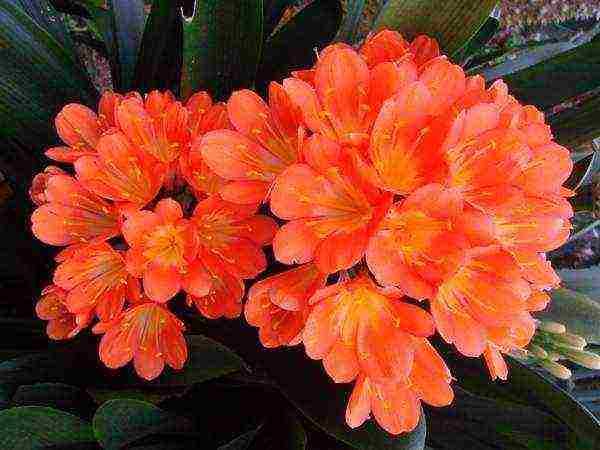 Bright clivia flowers
Bright clivia flowers
Occasionally you need to wipe the leaves with a damp soft cloth.
Bell-shaped red, yellow or orange flowers, collected in an inflorescence on a high peduncle, look bright and very impressive.
Vriezia
A bright representative of the "atmospheric" bromeliads. The 70-centimeter inflorescence with bright bracts makes it memorable. For luxurious flowering, a stable temperature in the range of 19-28 degrees is required, and constant moisture to the outlet.
 Vriezia
Vriezia
Sempolia or Uzambara violet
This flower, although it needs a sufficient amount of light, does not tolerate direct sunlight: spots of burns appear on the leaves, their color fades, there is no flowering. The best option for placing violets is light partial shade, diffused light.
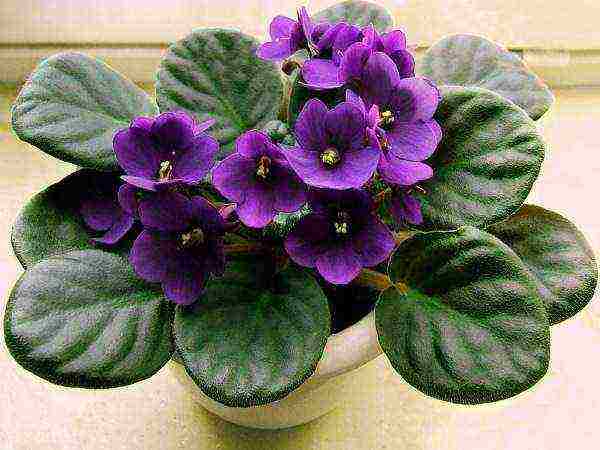 Violet is a very popular flower
Violet is a very popular flower
Decorative deciduous
The main advantage of ornamental deciduous plants is spectacular color of their leaves... At the same time, flowers can be small and inconspicuous.
Sansevieria
This plant of "strict lines" amateur flower growers call "mother-in-law's tongue" and "pike tail". Many varieties have been bred with various color combinations in the color of leathery leaves.
In partial shade, the contrast of color spots becomes brighter... In favorable conditions, sansevieria blooms, throwing out long "candles" of white and yellowish inflorescences.
 Sansevieria
Sansevieria
Ferns - love dark places
Among the many types, you can choose for both home and office, large or compact species. For example, broadleaf Asplenium or delicate thin-leaved Maidenhair (Venus hair).
All of them prefers shade or partial shade, moist air and soil.
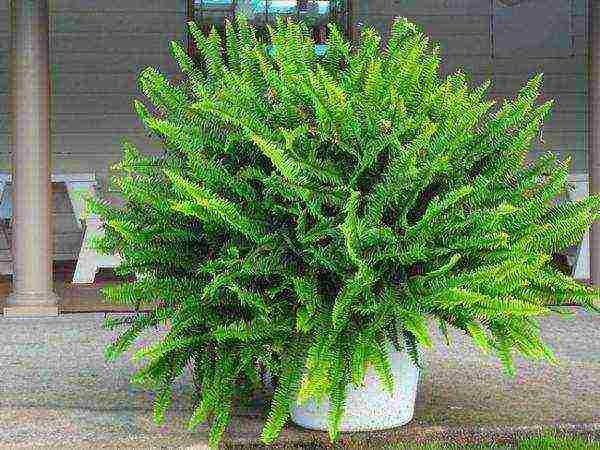 Ferns
Ferns
Fat woman (money tree)
The money tree does not tolerate shade well, but feels comfortable in dim lighting. Abundant watering is not required.
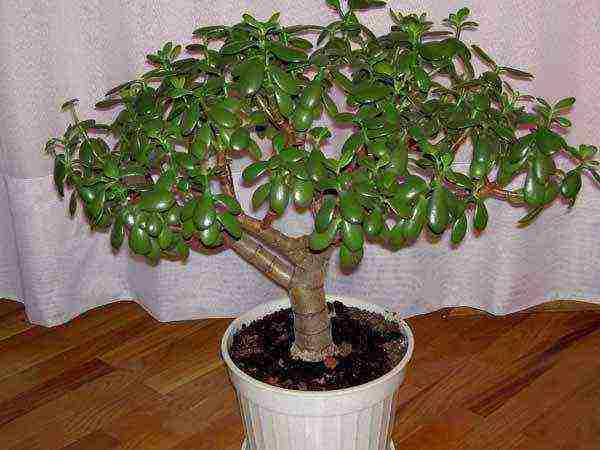 Money Tree
Money Tree
Ficus
Compact ampelous and dwarf species need partial shade, they bright light is contraindicated... Moderate watering, air humidification, temperatures above 12 degrees are required.
 Ficus
Ficus
Sheflera
It takes root well in a bright room, but at some distance from the window. Frequent spraying of the leaves is required and the temperature is maintained at 12 to 20 degrees. Bred compact and large species.
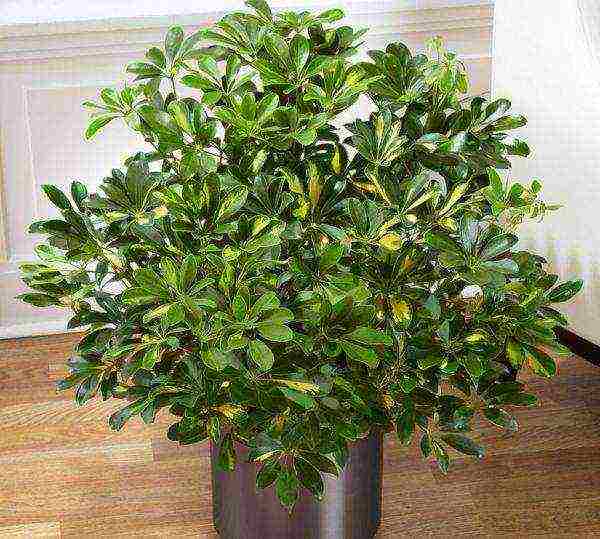 Sheflera
Sheflera
Palm trees and large trees for the home, growing in partial shade
Such plants will decorate a spacious room, office or winter garden.
Dracaena
A tree-like plant with a contrasting coloration of narrow, long leaves. Depending on the type of dracaena, it grows from 70 cm to 3 m in height. To preserve decorativeness, it is necessary sufficient, but not bright lighting, moderate moisture.
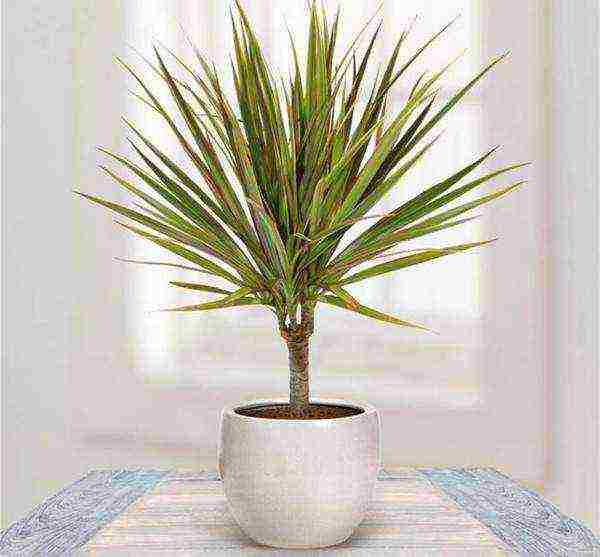 One of the types of dracaena
One of the types of dracaena
Cordilina
Height from 0.5 to 2 meters... Often grown in tubs. It differs not only in a variety of colors, but also in the shape of the leaves: they are very narrow, long, lanceolate, wide, round. Cordilina is often confused with dracaena.
 Cordilina on the windowsill on the north side
Cordilina on the windowsill on the north side
Monstera
Can't stand bright lighting at all... Loves "water treatments" - wiping and polishing leaves, spraying, abundant watering in summer and moderate in winter.
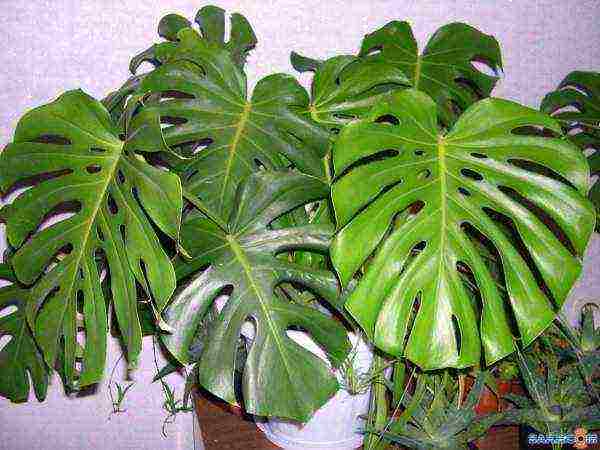 Monstera
Monstera
Palm
Under this name, various species are combined that have one feature: a single growth point at the top of the stem. Most palms grown in indoor culture love partial shade, abundant watering in summer and less intense in winter, humid air.
Everyone does not tolerate drafts and transplants.
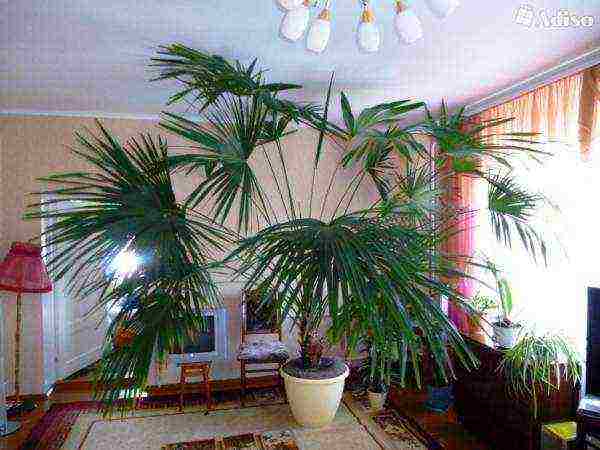 Palm
Palm
Curly shade tolerant
Climbing plants and vines are used to decorate the walls, create volumetric compositions.
Philodendron climbing
Does not tolerate direct sunlight and strong shade. Best accommodation - in bright but diffused light or in partial shade. Humidification is weak in winter, frequent and abundant in summer.
 Philodendron climbing
Philodendron climbing
Tradescantia
There are a huge number of species of this ampelous plant with a variety of leaf colors. To preserve decorativeness, he need partial shade or indirect bright lighting.
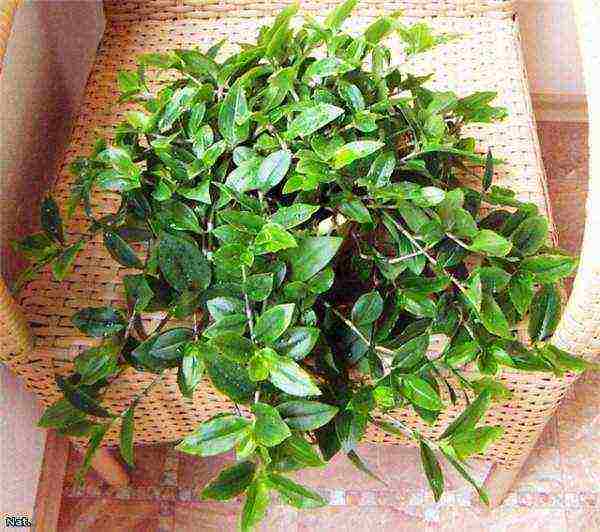 Tradescantia
Tradescantia
Cissus
An excellent option for decorating large planes. The scope of imagination gives a variety of varieties - the leaves can be large leathery and small, tender, whole and dissected. It grows quickly, becomes attractive and decorates the room.
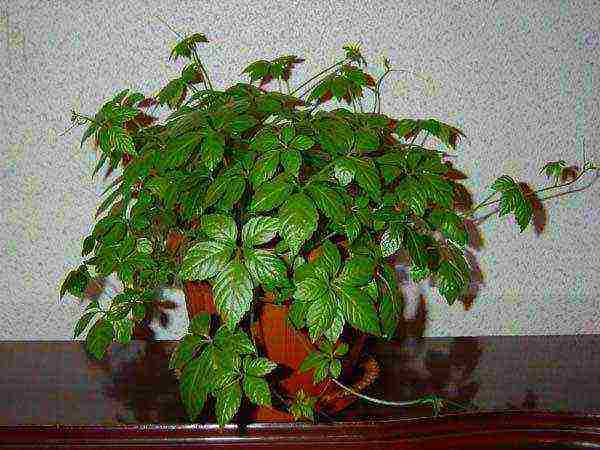 Cissus
Cissus
Features of shade-loving colors
All shade-loving plants have properties that distinguish them from others:
- the most vividly decorative qualities are manifested, if the flower is in the shade or partial shade most of the day;
- under intense lighting, development is inhibited, growth slows down, leaf color fades, flowering may not occur; in direct sunlight, the plant may get burned;
- need sufficient moisture in the soil and air;
- observance of the temperature regime is necessary;
- usually shade-loving do not tolerate frequent transplants.
Shade-loving plants are beautiful in their variety. They can be used to create refined, bright, stylish, light or respectable compositions that will become the main decoration of any room.

Buying another flower, we do not even know about some of the harmful properties of indoor plants, and then suddenly we notice emerging health problems. If a small child or animals live in the house, then you need to pay special attention to the choice of indoor flowers and plants in order to secure their life. Some plant species contain poison in their juice or release harmful substances into oxygen.
In addition to plants that are not recommended to be kept at home, there is an adverse effect on the human body of some flowers. In this case, you need to correctly choose the location of the future green resident, without placing him in the bedroom or, conversely, in the kitchen.
There are a lot of disputes and disagreements about dangerous plants in the house. All sayings are mixed with various signs that can eventually confuse a novice gardener.
In this article, we'll take a look at the plants to be careful with and be aware of the likely effects on the body and energy.
List of poisonous plants
This group of plants includes those species that should not be kept at home, especially in the presence of animals or children due to extremely dangerous properties. A child, like a pet, is capable of poisoning with similar flowers or getting burns if handled carelessly.
If there are no children and animals in the house, then take precautions when caring for such plants. Be sure to wear gloves when handling these colors and rinse tools thoroughly. Do not under any circumstances cut these flowers with a knife intended for food in your kitchen.
Consider this group of plants:
- Dieffenbachia (Dieffenbachia).
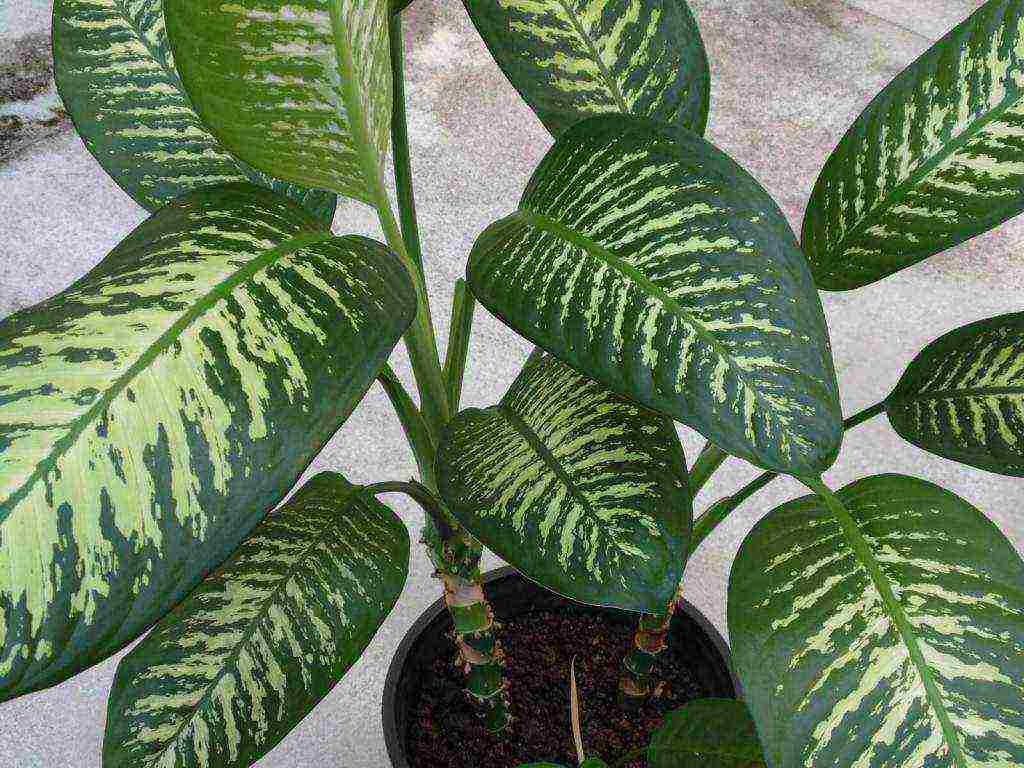 A popular indoor plant that attracts flower growers with huge yellow-green leaves that form a fluffy crown. The flower is dangerous for its sap, which is released when the leaves or stem are cut. If a pet or a child decides to chew any part of this flower, then the juice that gets into the body will cause severe poisoning. In addition, dieffenbachia juice causes burns and irritation to the skin.
A popular indoor plant that attracts flower growers with huge yellow-green leaves that form a fluffy crown. The flower is dangerous for its sap, which is released when the leaves or stem are cut. If a pet or a child decides to chew any part of this flower, then the juice that gets into the body will cause severe poisoning. In addition, dieffenbachia juice causes burns and irritation to the skin. - Oleander (Nerium oleander).
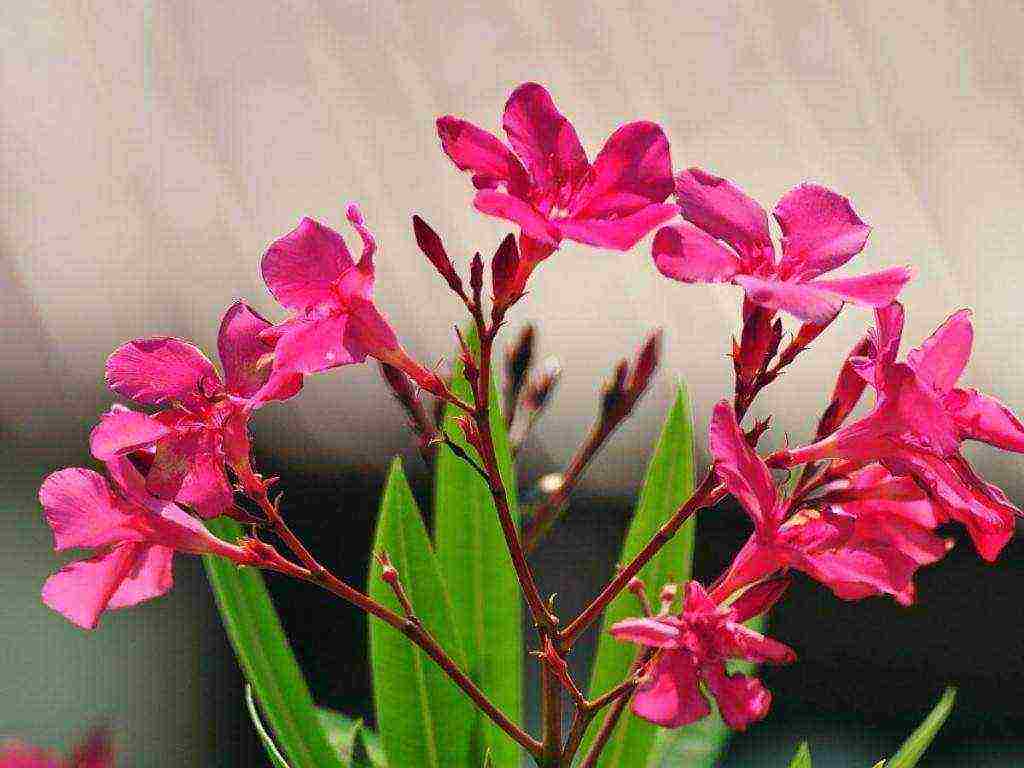 Popular for its bright crimson flowers. The ingestion of oleander juice into the body causes blindness. The scent of a flowering plant contributes to dizziness and feeling unwell.
Popular for its bright crimson flowers. The ingestion of oleander juice into the body causes blindness. The scent of a flowering plant contributes to dizziness and feeling unwell. - Euphorbia (Euphorbia).
 This plant is represented by a huge number of species and various forms, therefore, it cannot be described unequivocally. Many representatives are similar in appearance to cacti and have thorns, the prick of which is also dangerous for a living organism. Euphorbia contains white sap in its stem and leaves, which causes burns and irritation to the skin. When ingested, it causes poisoning.
This plant is represented by a huge number of species and various forms, therefore, it cannot be described unequivocally. Many representatives are similar in appearance to cacti and have thorns, the prick of which is also dangerous for a living organism. Euphorbia contains white sap in its stem and leaves, which causes burns and irritation to the skin. When ingested, it causes poisoning.
By the way, on our website there is a large article about caring for this plant, so we recommend that you read it!
- Croton (Croton).
 If we talk about this plant, which belongs to the euphorbia family, it looks like a small tree with variegated leaves that have an elongated shape. Its flowers are inconspicuous, and it rarely blooms at home. The sap of this plant causes burns on the skin. If the juice gets into the bloodstream when cut or ingested, then the case may end in death or resuscitation.
If we talk about this plant, which belongs to the euphorbia family, it looks like a small tree with variegated leaves that have an elongated shape. Its flowers are inconspicuous, and it rarely blooms at home. The sap of this plant causes burns on the skin. If the juice gets into the bloodstream when cut or ingested, then the case may end in death or resuscitation. - Azalea (Azalea).
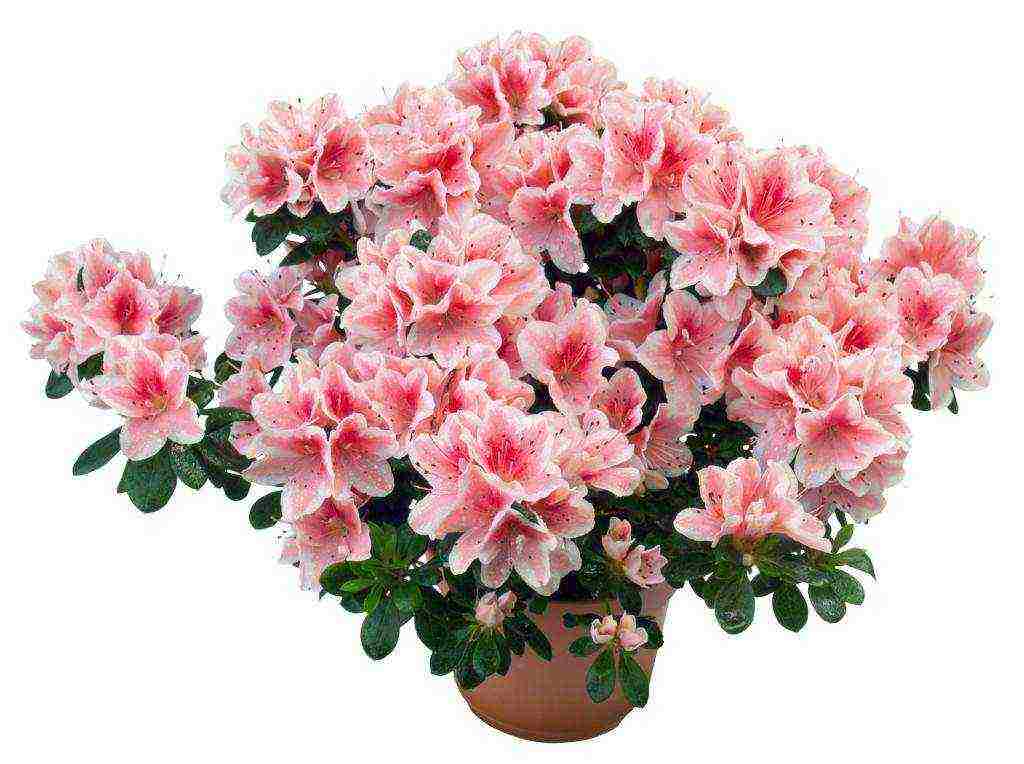 A common plant among flower lovers. It is famous for its lush and attractive flowering. The colors are very diverse: white, pink, red, yellow in azalea flowers. It is the Azalea of Simsa (Indian Azalea) that is considered dangerous. Ingestion of the leaves of this flower causes intestinal colic and cramps.
A common plant among flower lovers. It is famous for its lush and attractive flowering. The colors are very diverse: white, pink, red, yellow in azalea flowers. It is the Azalea of Simsa (Indian Azalea) that is considered dangerous. Ingestion of the leaves of this flower causes intestinal colic and cramps. - Mimosa bashful (Mimosa pudica).
 A bizarre plant that externally is represented by thin stems and small leaves. The leaves look fragile and delicate, and upon contact with an object, they curl up into a tube. Long-term human contact with these flowers leads to hair loss and loss. Sometimes it comes to complete baldness. The fact is that this plant emits harmful and toxic substances that poison the human body.
A bizarre plant that externally is represented by thin stems and small leaves. The leaves look fragile and delicate, and upon contact with an object, they curl up into a tube. Long-term human contact with these flowers leads to hair loss and loss. Sometimes it comes to complete baldness. The fact is that this plant emits harmful and toxic substances that poison the human body. - Evergreen ivy (Hedera).
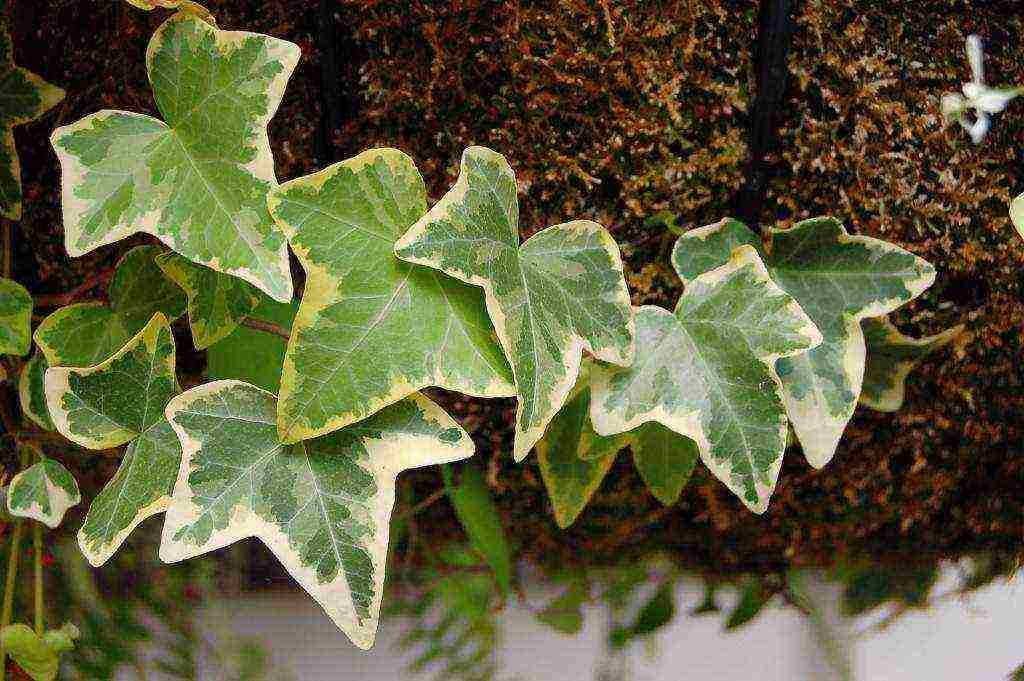 This plant belongs to the Araliaceae family. It is a shrub in the form of vines. Cats are very attracted to the bright green color of the leaves of this plant, but in ivy, the leaves and berries are poisonous, so the animal can die or be severely poisoned.
This plant belongs to the Araliaceae family. It is a shrub in the form of vines. Cats are very attracted to the bright green color of the leaves of this plant, but in ivy, the leaves and berries are poisonous, so the animal can die or be severely poisoned. - Adenium (Adenium).
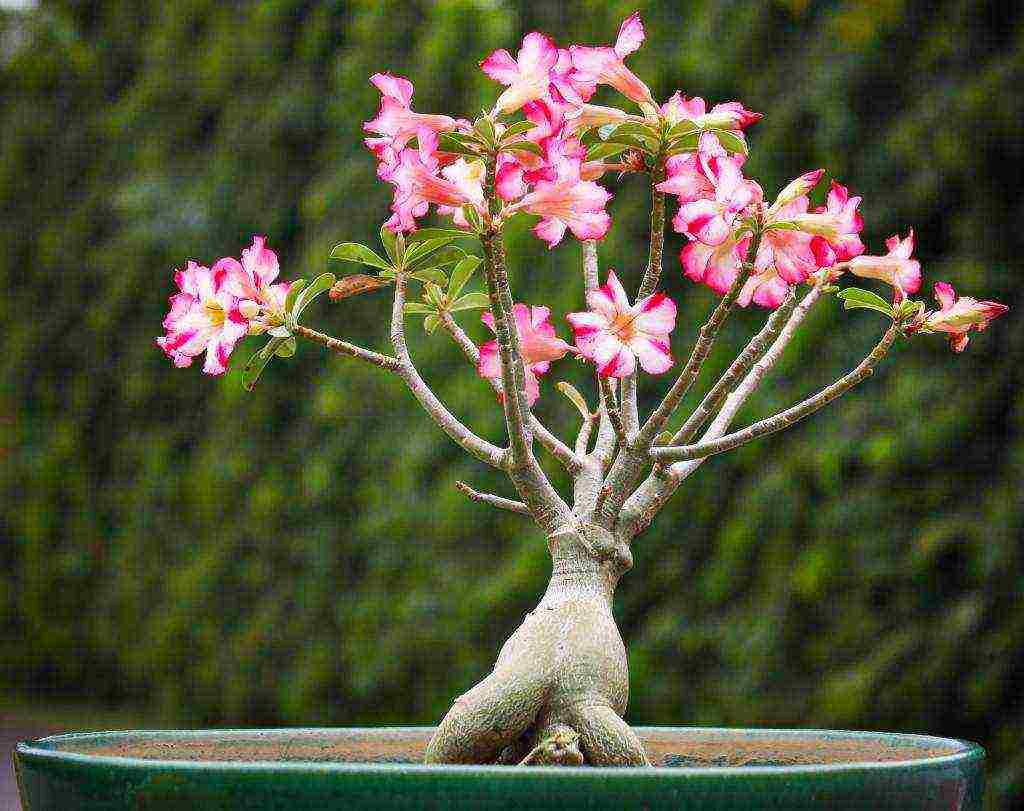 A very beautiful plant, which is represented by a thick, obese stem in the form of a small tree trunk. At the top are sparse leaves and a large number of medium-sized pink flowers. The plant is very toxic, adenium juice is especially dangerous. On contact with the body, it causes poisoning and burns.
A very beautiful plant, which is represented by a thick, obese stem in the form of a small tree trunk. At the top are sparse leaves and a large number of medium-sized pink flowers. The plant is very toxic, adenium juice is especially dangerous. On contact with the body, it causes poisoning and burns. - Monstera.
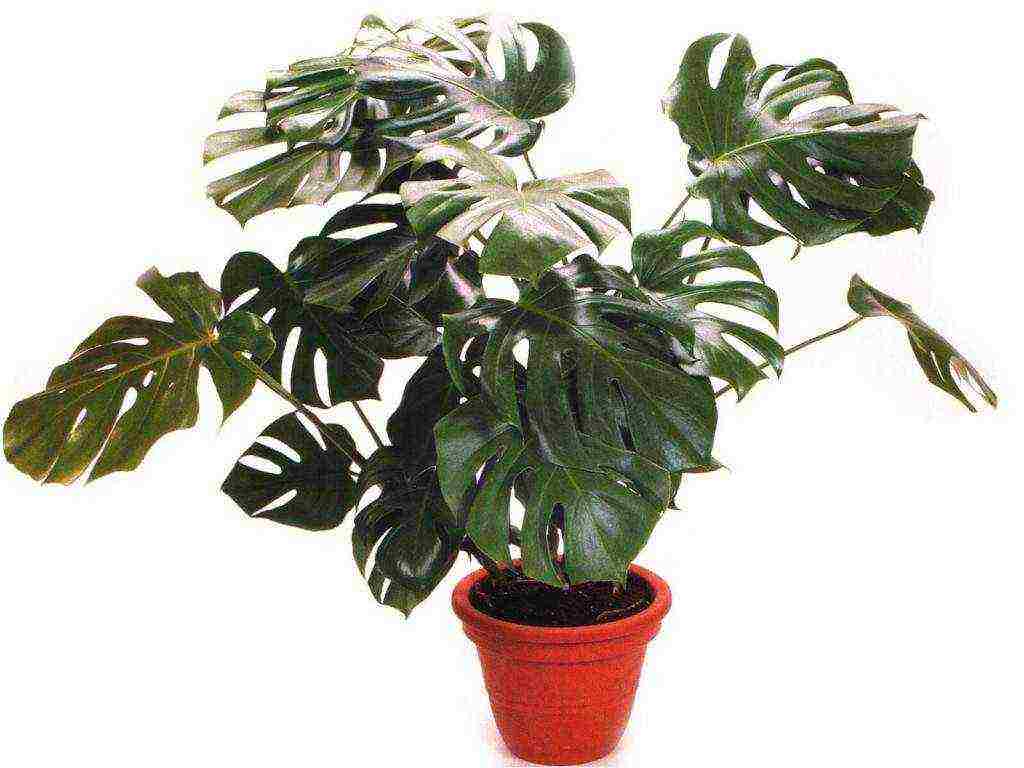
Monsterra is not a very dangerous plant, but still it is better not to start it at home.
A spectacular plant with huge leaves and growing to impressive sizes. Usually, monstera can be found in public places or botanical gardens. Monstera juice can cause burns on the skin, upset the digestive system, and if it gets into the eyes, damage them.
- Philodendron
 Belongs to the aroid family. The plant is represented by bushes, vines and lush greenery. Philodendron juice is poisonous. Contact with skin and eyes causes irritation and burns.
Belongs to the aroid family. The plant is represented by bushes, vines and lush greenery. Philodendron juice is poisonous. Contact with skin and eyes causes irritation and burns. - Primula (Primula).
 The flower has gained such popularity due to the beautiful flowering of various shades, small size and velvety leaves. During flowering, the plant releases toxic substances that cause nausea and dizziness. The velvety leaves are covered with small villi, contact with which leads to burning sensation and allergies.
The flower has gained such popularity due to the beautiful flowering of various shades, small size and velvety leaves. During flowering, the plant releases toxic substances that cause nausea and dizziness. The velvety leaves are covered with small villi, contact with which leads to burning sensation and allergies. - Stellera dwarf (Stellera chamaejasme).
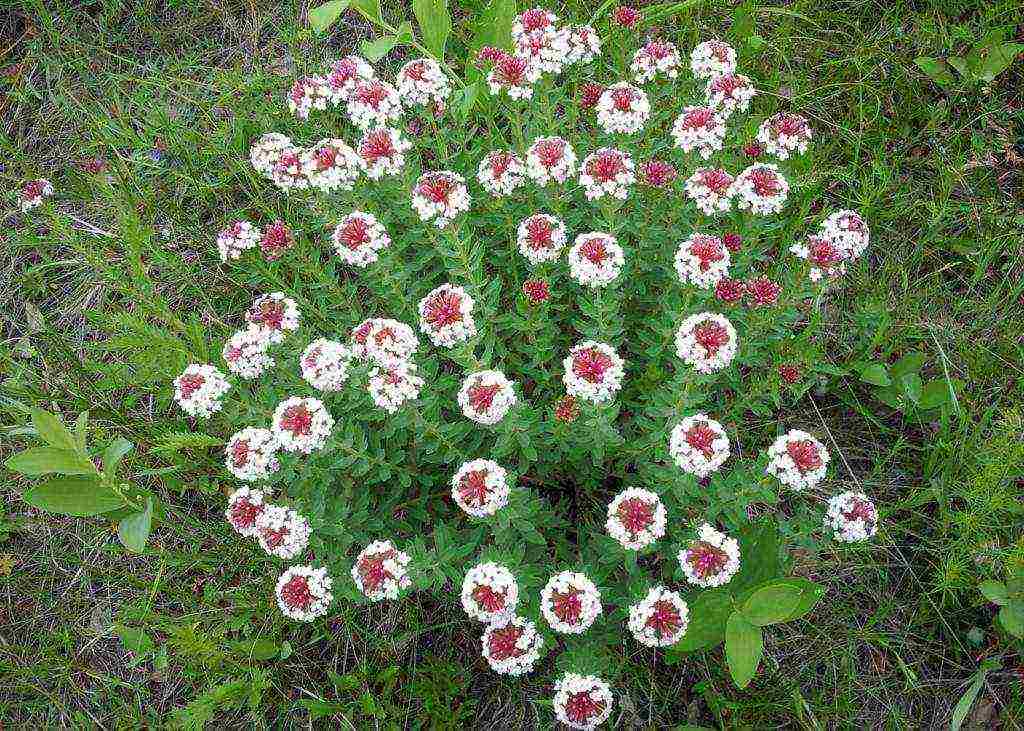 In the photo, Steller is in natural habitat. This plant is known for its medicinal properties, but it can only be used for such purposes under the supervision of a doctor. The flower itself has a high stem on which the inflorescences are located. They consist of 20-30 small white flowers. The ingestion of the leaves of the plant in its raw form into the body leads to swelling of the vocal cords and even to numbness.
In the photo, Steller is in natural habitat. This plant is known for its medicinal properties, but it can only be used for such purposes under the supervision of a doctor. The flower itself has a high stem on which the inflorescences are located. They consist of 20-30 small white flowers. The ingestion of the leaves of the plant in its raw form into the body leads to swelling of the vocal cords and even to numbness. - Nightshade (Solanum).
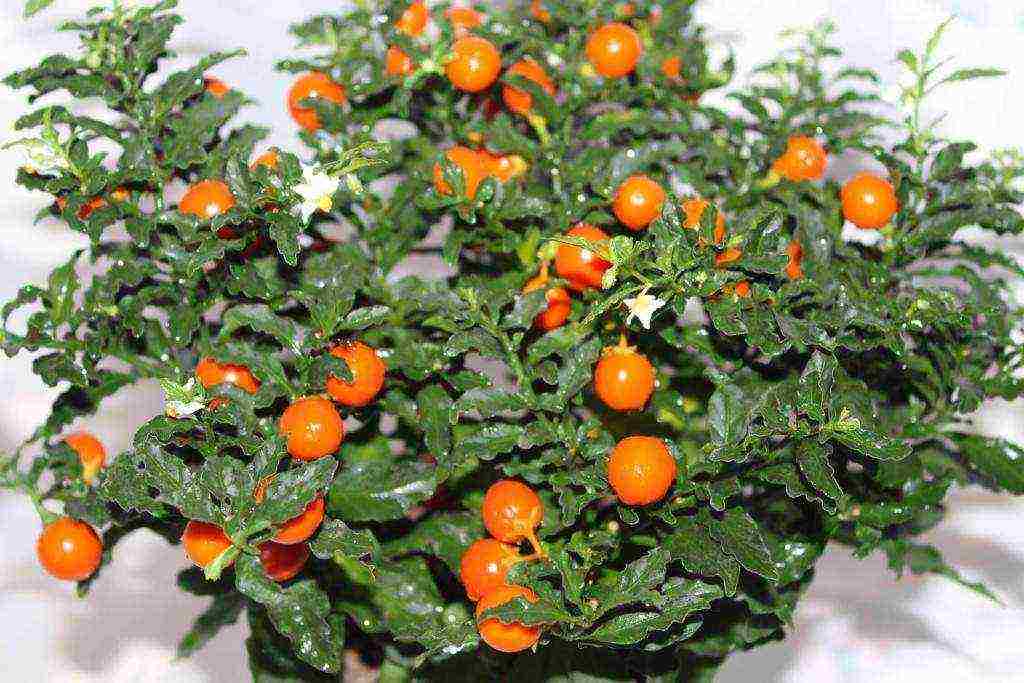 This flower attracts attention with its bright orange fruits that adorn the evergreen shrub. It is these fruits that are very poisonous and dangerous. May cause poisoning. The bright color of the berries attracts children and animals, so you should not keep such a flower at home.
This flower attracts attention with its bright orange fruits that adorn the evergreen shrub. It is these fruits that are very poisonous and dangerous. May cause poisoning. The bright color of the berries attracts children and animals, so you should not keep such a flower at home. - Tulip Gesner (Tulipa gesneriana).
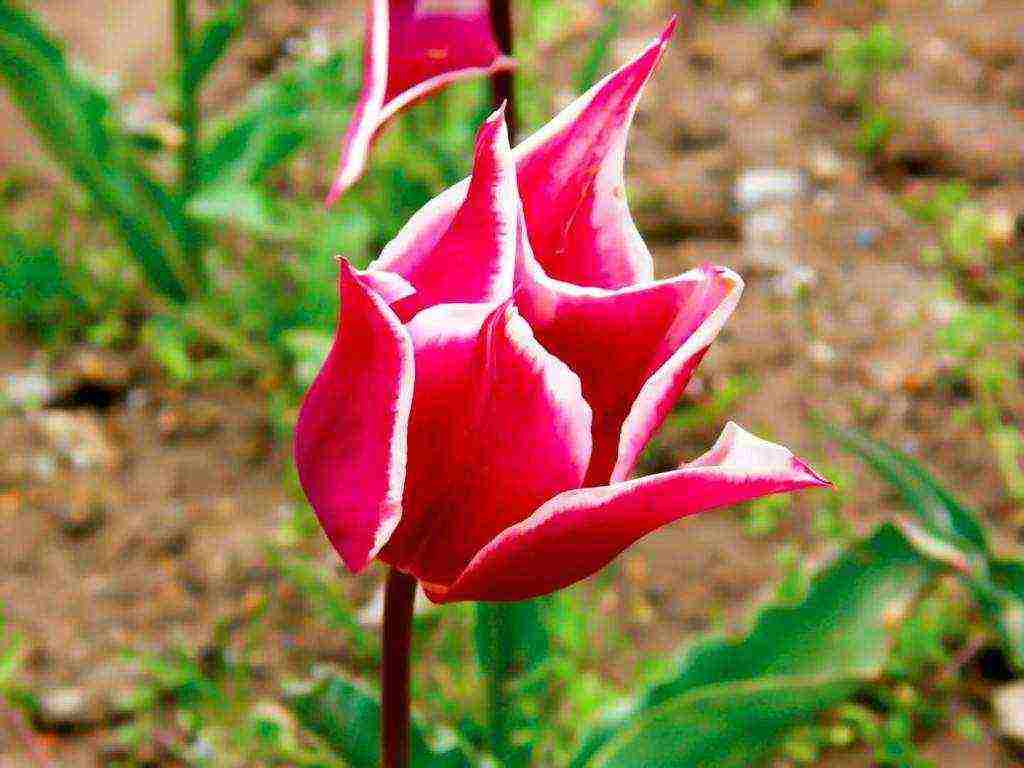 This plant blooms very impressively. It has a medium-sized stem on which a large flower is located. The color is varied - from yellow to red. But being with this flower for a long time indoors leads to hair loss and baldness.
This plant blooms very impressively. It has a medium-sized stem on which a large flower is located. The color is varied - from yellow to red. But being with this flower for a long time indoors leads to hair loss and baldness. - Trichocereus (Trichocereus).
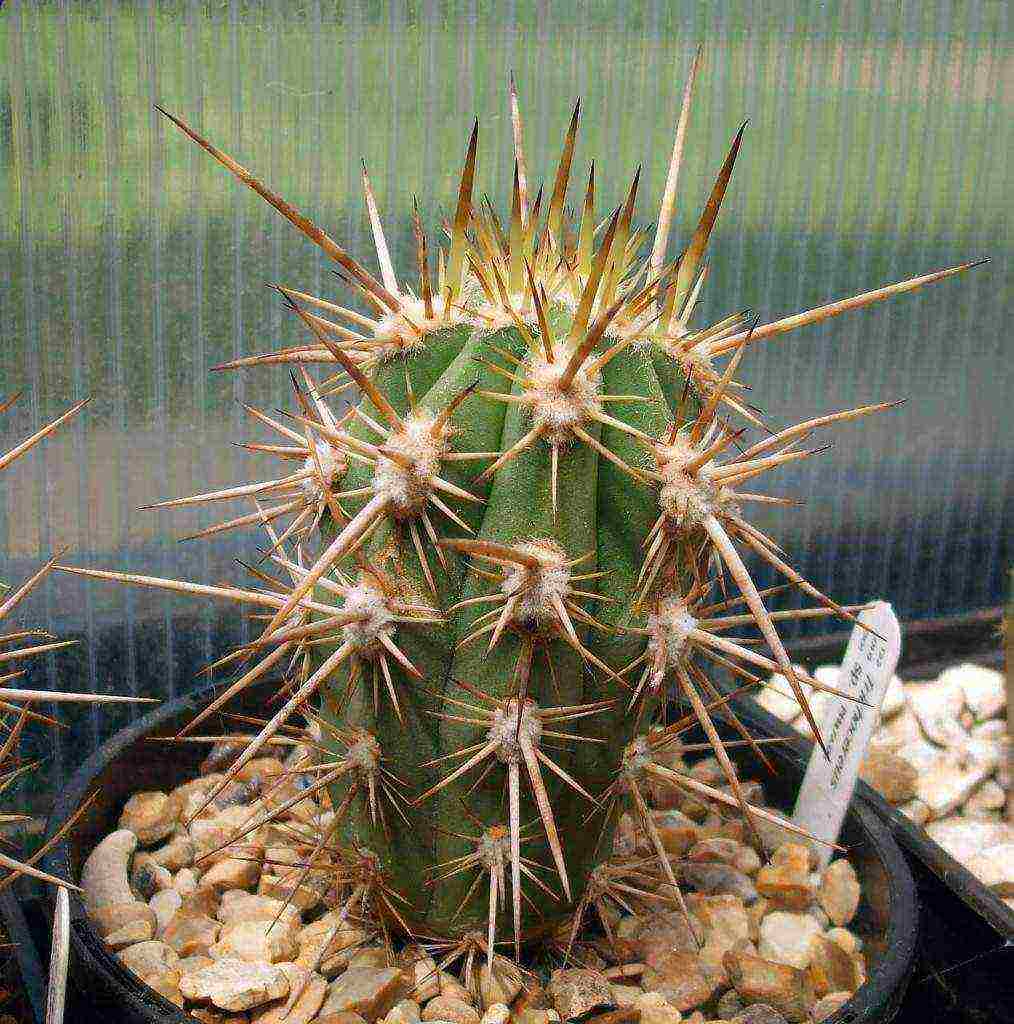 This plant is a species of cactus. It has long and large needles and blooms with large white flowers with a pleasant aroma. The plant contains hallucinogens and toxins that cause paralysis of the nervous system.
This plant is a species of cactus. It has long and large needles and blooms with large white flowers with a pleasant aroma. The plant contains hallucinogens and toxins that cause paralysis of the nervous system.
By families
The list of poisonous plants seems to be much longer, so when buying a flower, ask which family it belongs to. There are 4 main families of the most poisonous plants, namely:
- The euphorbia family. The juice of many members of this class is poisonous and causes burns on the skin.
- Aroid family. Most members of this group are toxic plants. Their juice is especially dangerous.
- A family of kurtovs. This class includes the most dangerous plants for human and animal life. They attract with their bright and variegated appearance. Wear gloves when working with this family of flowers.
- The nightshade family. In this class, not all plants are poisonous, because the well-known potatoes and tomatoes belong to this family. But house flowers are most often toxic, and especially their fruits. Berries cause indigestion, nausea, vomiting.
Watch the video for details:
Sometimes indoor plants are not only beautiful, but also dangerous. For this reason, be sure to use protective equipment when working with flowers. If, in spite of everything, you decide to acquire such flowers, then try to protect them from possible contact with animals and children.
List of plants to be treated with caution
There are a number of indoor flowers that can harm the human body only if they are incorrectly positioned in the house. In addition, some plant species cause allergies or mild ailments. The list of these plants is as follows:
- Lily (Lilium).
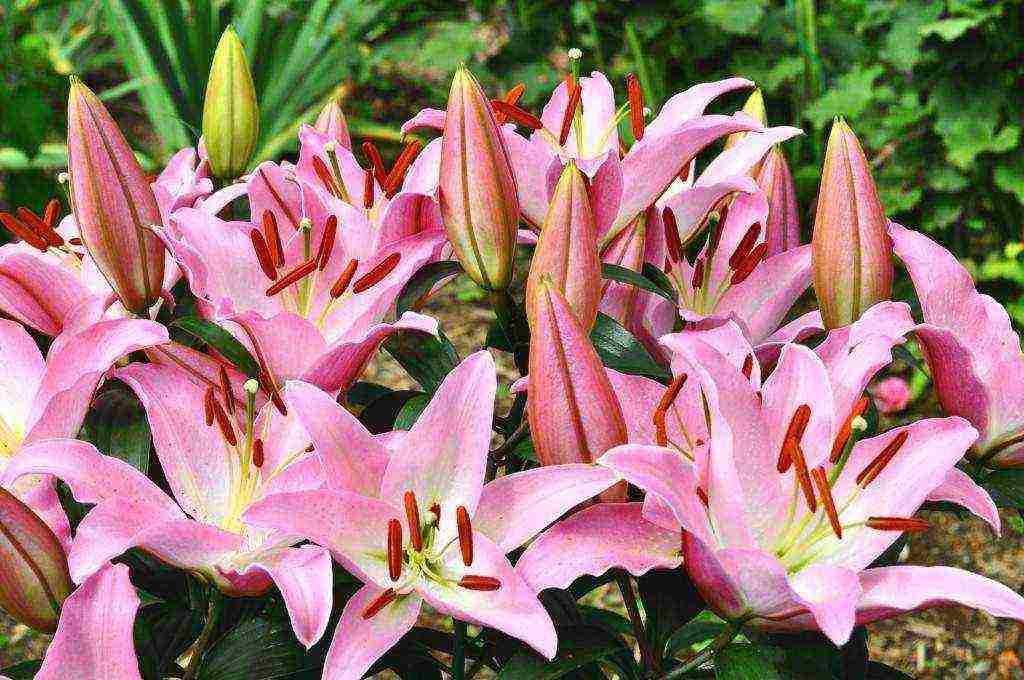 A flower loved by many with a tart aroma. It is because of this concentrated smell that they are not recommended to be kept in the bedroom, as they can cause insomnia. At night, lilies emit a lot of carbon dioxide, so in the morning you can wake up with a headache and tired.
A flower loved by many with a tart aroma. It is because of this concentrated smell that they are not recommended to be kept in the bedroom, as they can cause insomnia. At night, lilies emit a lot of carbon dioxide, so in the morning you can wake up with a headache and tired. - Ficus.
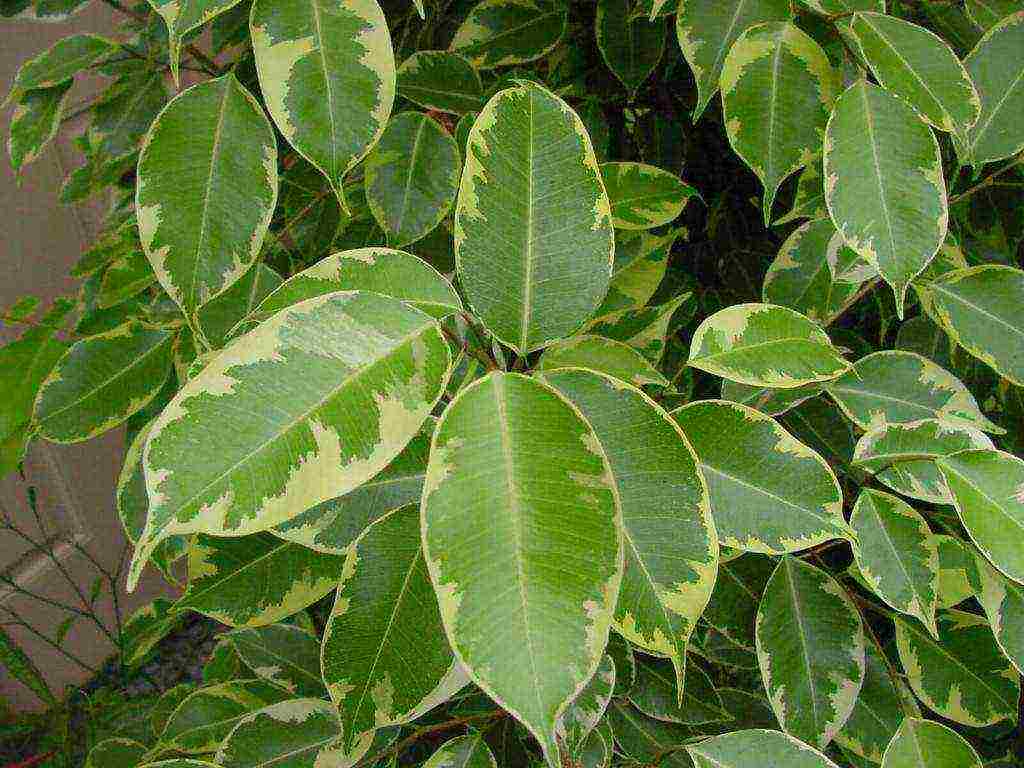 A lush green plant with oblong leaves. Ficus is not very dangerous for humans, but it is capable of causing allergic reactions more than others.
A lush green plant with oblong leaves. Ficus is not very dangerous for humans, but it is capable of causing allergic reactions more than others. - Orchid (Orchidaceae).
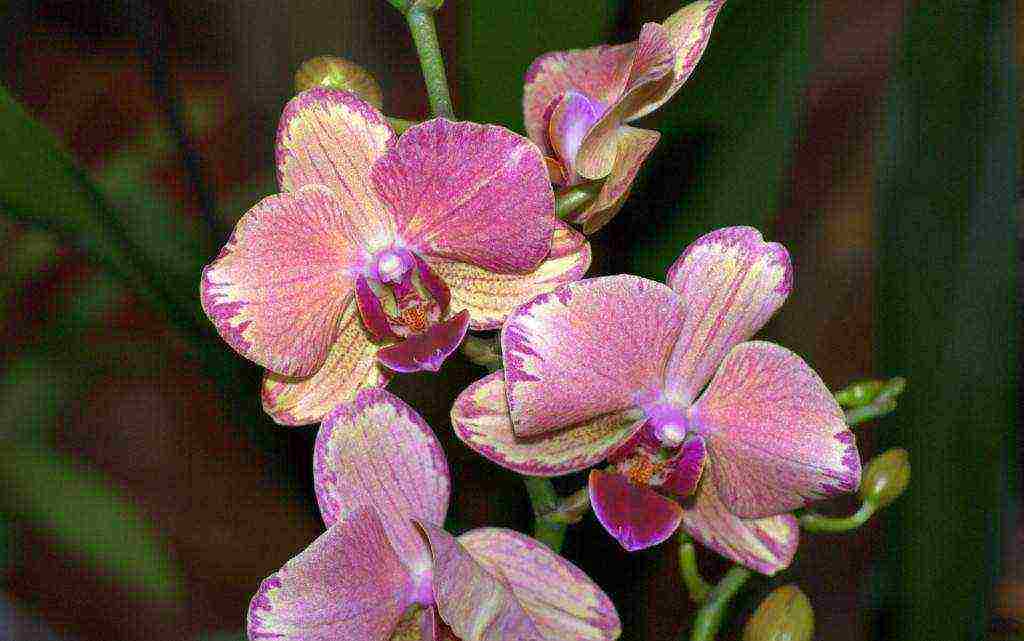 A beautiful plant with unusual flowering of various shapes and colors. It is better to place such a flower next to the workplace for the reason that it excites the nervous system. If you put an orchid in the bedroom, then it will lead to sleep disturbance.
A beautiful plant with unusual flowering of various shapes and colors. It is better to place such a flower next to the workplace for the reason that it excites the nervous system. If you put an orchid in the bedroom, then it will lead to sleep disturbance.
We have a whole section on the site dedicated to orchids. See if you can find a plant that suits you, they have beautiful flowers!
- Fern (Polypodiophyta).
Its action is similar to that of a lily. Fern gives off carbon dioxide at night, which leads to headaches in the morning. - Hydrangea (Hydrangea).
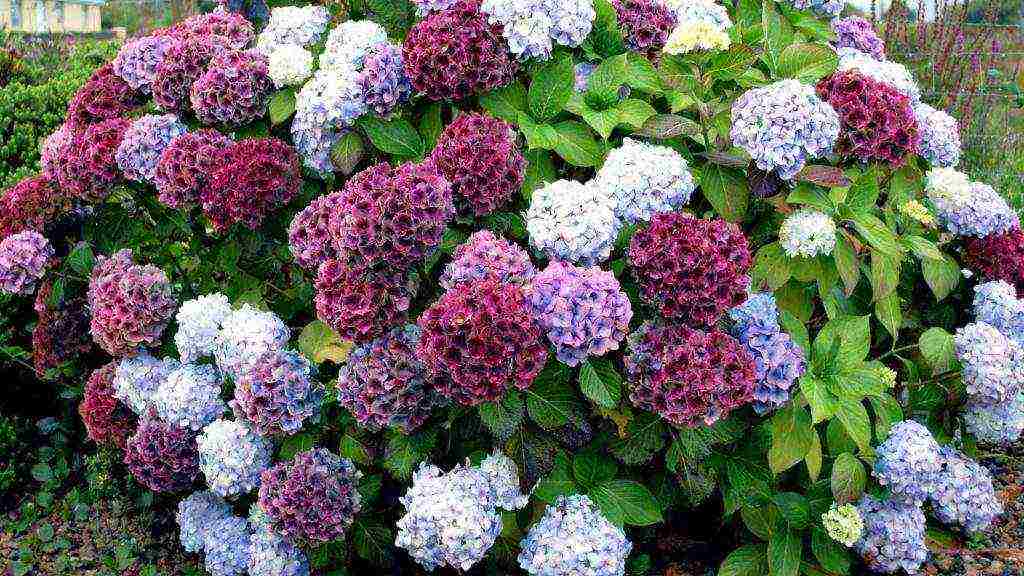 A flower that strikes with its inflorescence with a large number of small flowers forming a "cap". The color is varied from pink to blue shades. Hydrangea gives off particles that can cause allergies.
A flower that strikes with its inflorescence with a large number of small flowers forming a "cap". The color is varied from pink to blue shades. Hydrangea gives off particles that can cause allergies. - Tuberose (Polianthes tuberosa).
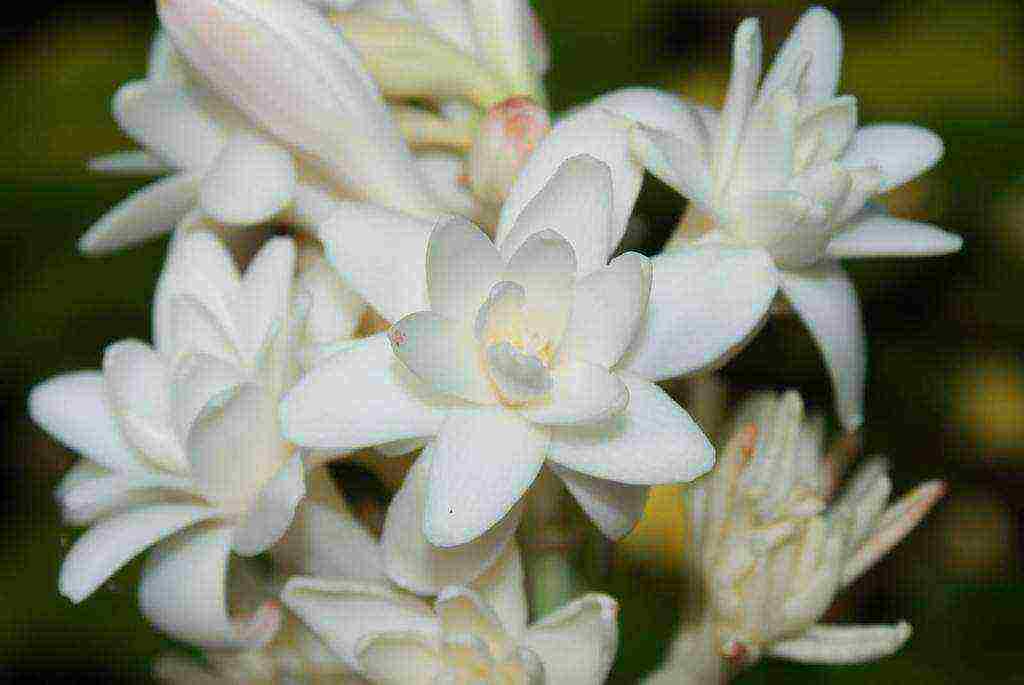 It is a perennial plant with a stem 45 cm high, white flowers form at the top. It has a very sweet and strong aroma. The plant secretes particles that greatly exacerbate the sense of smell. It is not recommended to keep such a flower for people with heart disease and hypertension. With such diseases, the scent of a flower can cause dizziness and mood loss, up to depressive states.
It is a perennial plant with a stem 45 cm high, white flowers form at the top. It has a very sweet and strong aroma. The plant secretes particles that greatly exacerbate the sense of smell. It is not recommended to keep such a flower for people with heart disease and hypertension. With such diseases, the scent of a flower can cause dizziness and mood loss, up to depressive states.
All flowers with a strong aroma should be placed in a well-ventilated area. Then there will be no problems with feeling unwell.
Folk signs: what is possible, what is not?
To trust folk omens or not is a personal matter for everyone. At the same time, it is worth remembering that most often signs arise on the basis of long-term observations of ancestors. Consider what the appearance of some indoor plants in the house entails:
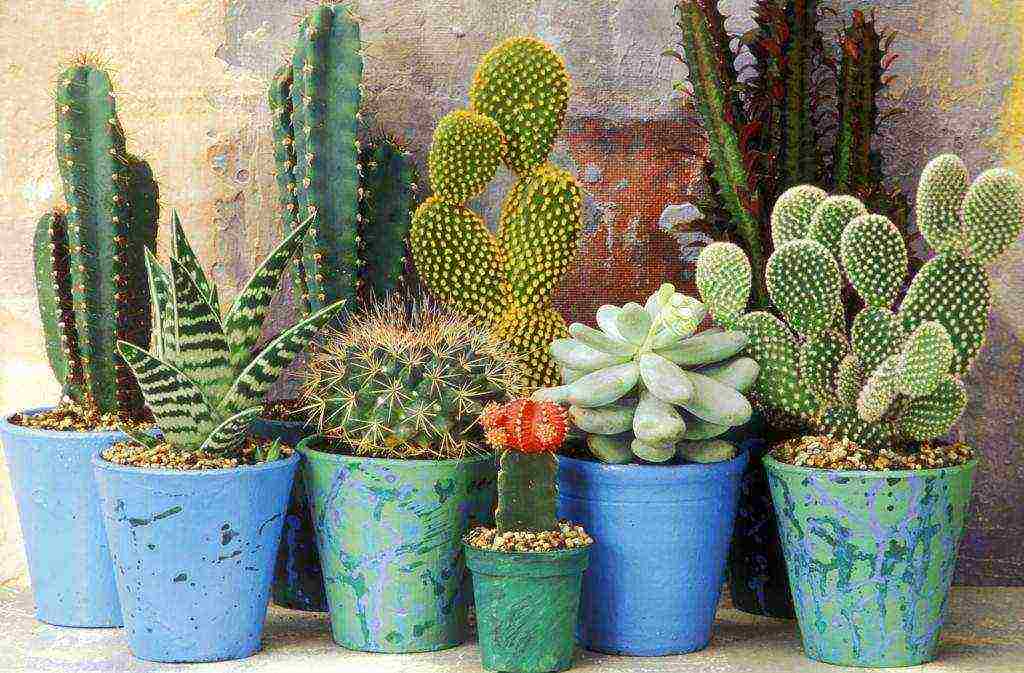 Cacti are unfavorable plants for the home. It is believed that the presence of a cactus in the apartment turns the husband into a person suffering from alcoholism. There is a second sign, which says that in a house where there is a cactus, a girl will not marry happily or will not meet a chosen one at all. Also, cactus has a bad effect on relationships between family members.
Cacti are unfavorable plants for the home. It is believed that the presence of a cactus in the apartment turns the husband into a person suffering from alcoholism. There is a second sign, which says that in a house where there is a cactus, a girl will not marry happily or will not meet a chosen one at all. Also, cactus has a bad effect on relationships between family members. - Ferns take vitality from a person, being an energy vampire. In a house with a fern, a person will feel constantly tired, inactive, sleepy.
- Ivy and climbing plants, according to folk signs, scare men away. In a house where there are such plants, a man will constantly strive to go somewhere. In addition, ivy negatively affects the state of mind, depriving a person of optimism and balance. It is best to keep these plants outside the house. So, ivy will act as a protector.
- Dieffenbachia is dangerous for its poisonous properties, and also takes health away from the household.
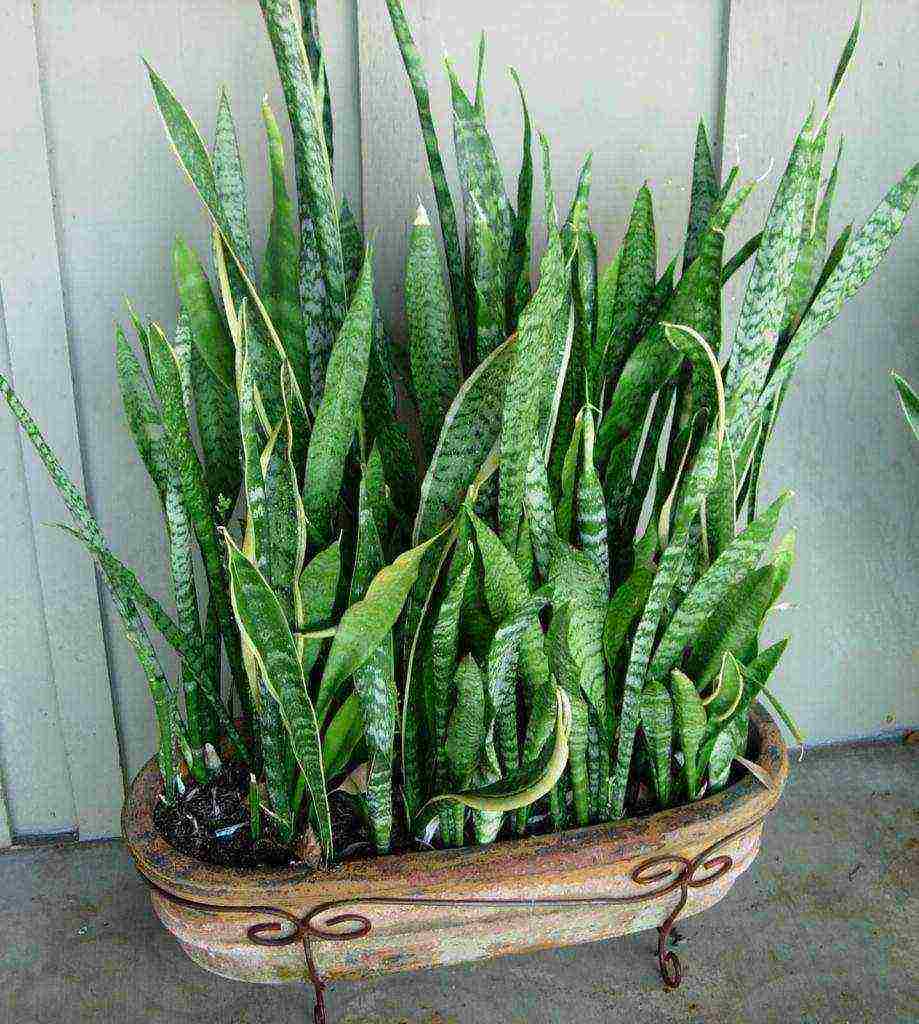 Mother-in-law's tongue is a plant that has practically no stem, with elongated longitudinal leaves with a bright green color. It is believed that the presence of such a flower in the house leads to loneliness and the inability of the girl to get married. The plant has a negative effect on feminine strength, so it is dangerous to keep it in the bedroom. The flower, as it were, "drives" men out of the house.
Mother-in-law's tongue is a plant that has practically no stem, with elongated longitudinal leaves with a bright green color. It is believed that the presence of such a flower in the house leads to loneliness and the inability of the girl to get married. The plant has a negative effect on feminine strength, so it is dangerous to keep it in the bedroom. The flower, as it were, "drives" men out of the house.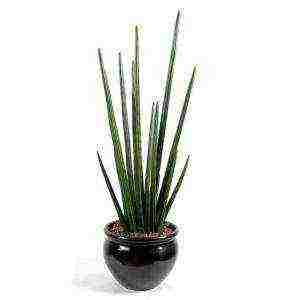 Sansevieria is a curious plant that looks like the tail of a fish. For this reason, it is also nicknamed the "pike tail". The leaves of the flower, painted green, have such a bizarre shape. The plant blooms and has a pleasant aroma. But, according to the signs, it negatively affects family and personal life. The presence of this flower in the house leads to loneliness.
Sansevieria is a curious plant that looks like the tail of a fish. For this reason, it is also nicknamed the "pike tail". The leaves of the flower, painted green, have such a bizarre shape. The plant blooms and has a pleasant aroma. But, according to the signs, it negatively affects family and personal life. The presence of this flower in the house leads to loneliness. - The palm tree often decorates the interiors of many rooms, but it is better not to put such a flower at home. The palm tree contributes to the appearance of grief in the family, if it was presented to you. Save this plant for office spaces or other locations.
- Ficus can cause allergies, but in addition, it is believed that the flower negatively affects the appearance of children in the house. If you want a child, then this plant is not worth purchasing. Ficus has long been controversial. There is a completely opposite opinion about this plant. It says that ficus solves the problem of infertility and contributes to family well-being.
Related videos:
When organizing a flower corner in an apartment or landscaping your home, choose the flowers that best suit you based on your lifestyle, the appearance of the flower and its properties.
Feng Shui
In Feng Shui, it is important to pay attention not only to the type of flower, but also to the state in which it is. There are several basic rules for keeping flowers and plants in the house according to Feng Shui:
- You should not keep dried flowers in the apartment.
- All old plants that no longer bloom and do not give young shoots should be thrown away.
- Sick flowers should not be kept in the house, as they will take away your health.
- A flower that you take care of for a long time, but all actions are useless, and it withers, should also be removed from the house. The plant spreads negative energy.
- It is worth choosing those flowers, the leaves of which are directed upwards. According to Feng Shui, such plants bring positive energy to the house. Plants with leaves that stretch down, on the contrary, land it.
- It is better to choose flowers with a rounded leaf shape.
- You shouldn't have a lot of plants in the bedroom and next to the bed.
- According to Feng Shui, all plants are divided into female and male (Yin and Yang). Women include begonia, violet, fat woman, cyclamen. Citrus fruits, dracaena, chlorophytum and others are considered male plants.
- For the most favorable energy field in the house, it is necessary to keep the Yin and Yang plants.
According to the rules of Feng Shui, there are no favorable or unfavorable types of flowers, but some are still not worth buying for keeping in the house. All plants with poor energy include those that have sharp leaves. It is believed that such flowers bring quarrels and discord to the family. Needles and thorns also provoke scandals, so you should choose plants with soft needles. The main plant that is not recommended to grow in Feng Shui at home is bonsai.
It is a dwarf tree whose growth has been artificially stopped. Such a tree will stop the development of its owner, negatively affect career success and general well-being.
List of Recommended Plants
For good energy in Feng Shui, it is recommended to grow the following flowers:
- Money tree - brings prosperity to the house in the material sense. In another way it is called "fat woman". It is recommended to plant such a tree with your own hands, and put a coin on the bottom of the pot.
 Bamboo absorbs bad energy and turns it into positive energy.
Bamboo absorbs bad energy and turns it into positive energy. 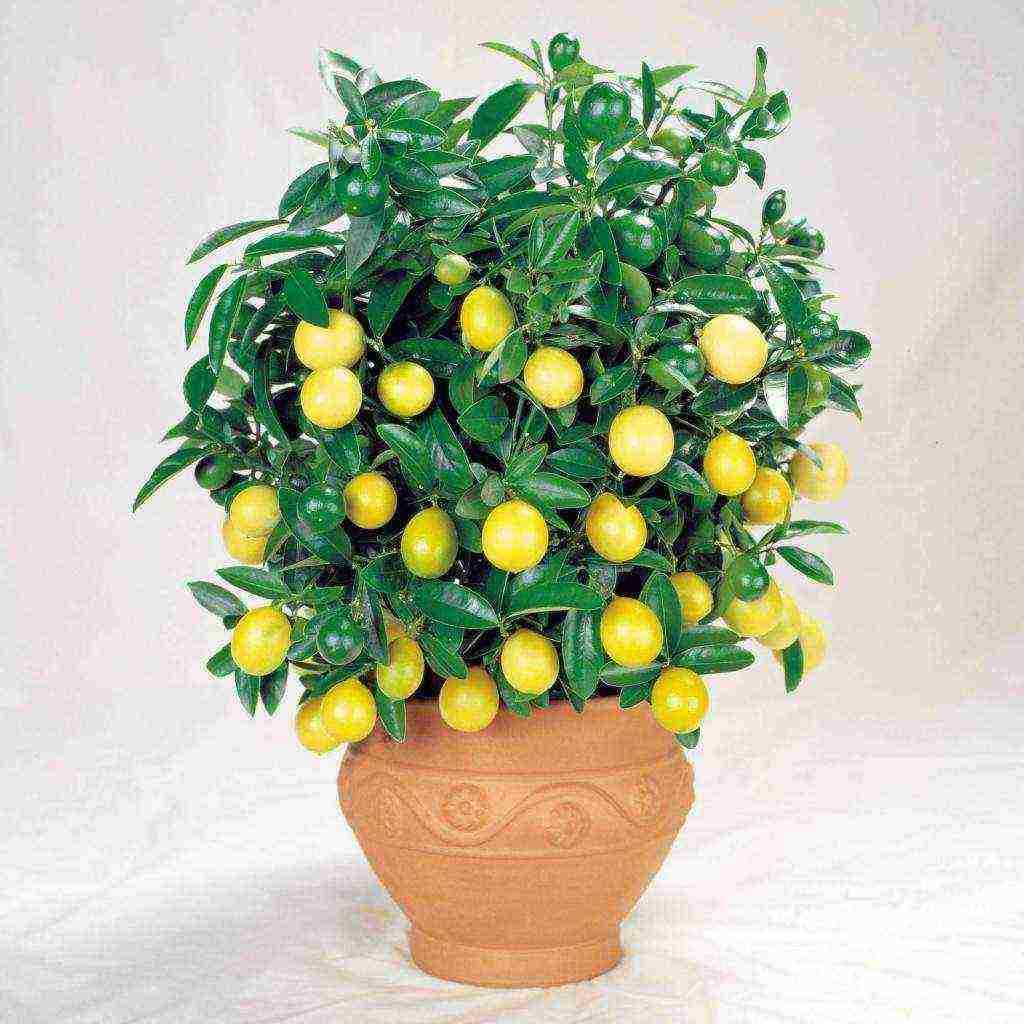 The lemon tree can increase activity and independence.
The lemon tree can increase activity and independence.- Ficus should be placed anywhere in the house, but not in the bedroom. If this plant is in the bedroom, then the relationship between the spouses may deteriorate. It is believed that ficus relieves aggression and neutralizes negative energy.
- Geraniums also cannot be placed next to the bed and in the bedroom. According to Feng Shui, it is believed that this flower secretes essential oils that soothe the nervous system and improve metabolism. But excessive inhalation of these oils causes allergies and headaches.
 The myrtle tree can improve the relationship in marriage. Promotes harmony in family life and revitalization of relationships.
The myrtle tree can improve the relationship in marriage. Promotes harmony in family life and revitalization of relationships. - The cactus has a heavy energy, but it can reduce irritability and rage.Recommended for people with a hot temperament.
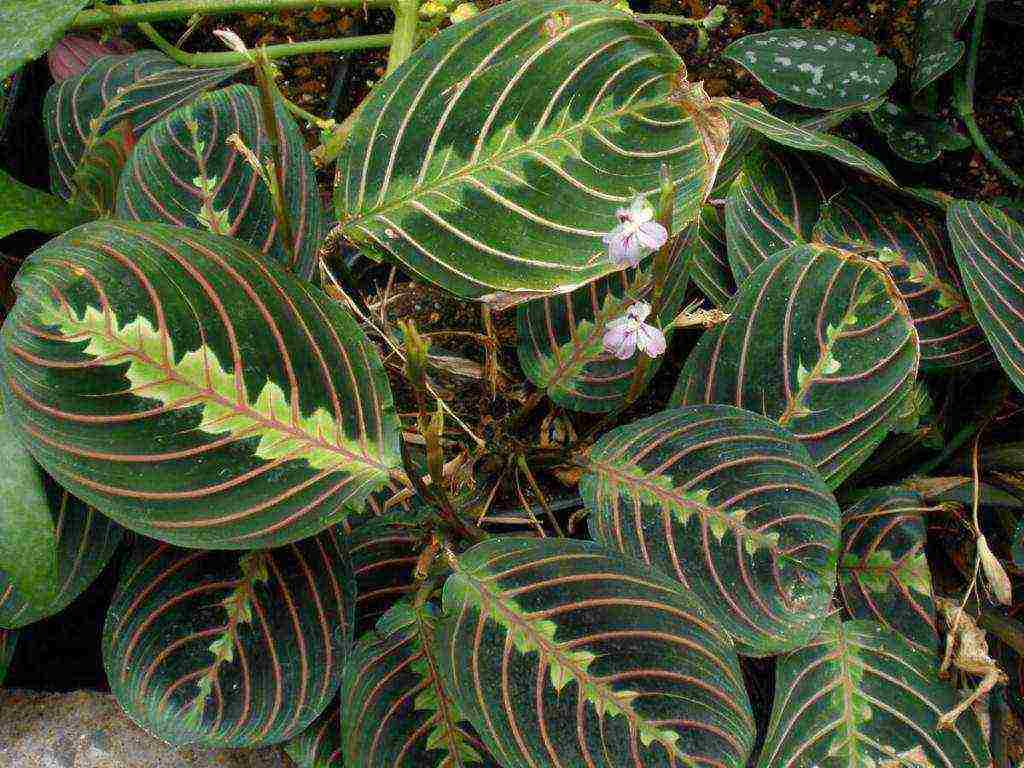 Arrowroot, poinsettia help those who have lost it to find the meaning of life and find professional harmony.
Arrowroot, poinsettia help those who have lost it to find the meaning of life and find professional harmony.
Videos about plants and feng shui:
Conclusion
In conclusion, I would like to say that the choice of indoor plants is more dependent on your personal preferences. Observe safety precautions when handling poisonous flowers. Do not forget about their danger to children and animals.

